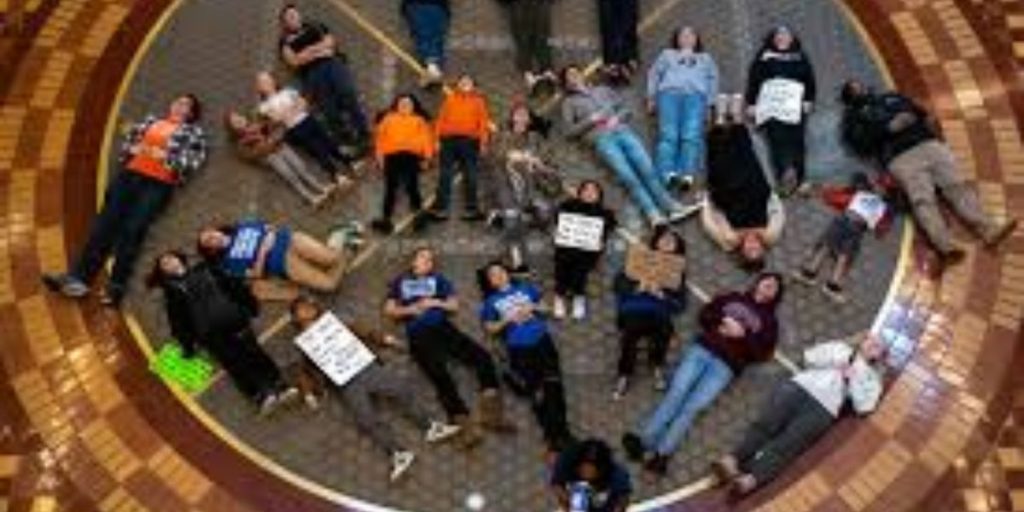The end of the 90th General Assembly is approaching. Iowa House members have begun giving retirement remarks on the floor, indicating that fewer debates are ahead than behind, and some of the jigsaw-puzzle measures that comprise the state budget have been submitted.
This year’s budget appears to be similar to the last seven under all-Republican administration in Iowa: largely status quo expenditure, tiny increases in general funding for K-12 schools and other restricted initiatives, and significant tax rate cuts.
However, zooming in shows a number of perplexing dichotomies in how the majority Republicans are allocating tax and other resources.
Here are three ways legislators are thinking about spending that money, as well as three alternatives with roughly comparable cash amounts.
Feed students instead of arming instructors.

House File 2586, which is currently up for discussion, would make an undefined sum of money available to pay for school security measures, with an earlier draft estimating $3 million. These “upgrades” could include investment on weaponry and training for school personnel.
Republicans support such spending, but they did not act on House File 2140, which would spend approximately $2.2 million to raise almost $29 million in federal funds to allow low-income families to purchase food during the summer, when school breakfast and lunch programs are not accessible. House File 575, which would allow pupils qualified for reduced-price meals at school to receive them for free, has also been ignored during the last two years, despite having 18 Republican cosponsors.
Care for new mothers and newborns instead of chasing such significant tax cuts.

The gun comparison is a specific example of a larger pattern in Iowa Republicans’ money management: strict scrutiny of disfavored expenses, typically spending on safety-net or other programs that benefit everyone, while authorizing eight- and nine-figure tax cuts that disproportionately benefit higher-income Iowans.
On Wednesday, lawmakers passed Senate File 2251 to Governor Kim Reynolds, which will eventually allow some low-income women and infants to obtain Medicaid health coverage for 12 months following the end of a pregnancy, rather than two months. Iowa is among the last states to take this step. To make it happen, politicians amended eligibility requirements, resulting in almost 1,000 fewer women and several hundred fewer babies receiving government health coverage each month.
The Iowa Senate approved the bill in February. A few weeks later, the nonpartisan Legislative Services Agency issued a revised analysis predicting that, rather than saving the state money for a few years, as an earlier analysis suggested, the changes would cost about $5 million over three transition years, with annual costs about $300,000 higher than they are now.
All of this amounts to rounding errors in the state’s $9 billion-plus budget, which has long boasted multibillion-dollar surpluses. Remember that this is to ensure that women and babies receive health care throughout some of their most critical times in life. Nonetheless, House Speaker Pat Grassley told reporters on March 14 that “I don’t want to be passing bills that have that level of fiscal impact without having a better idea of what our budget is going to look like.”
Meanwhile, efforts to reduce income tax rates continue, and lawmakers are working on measures to eventually eliminate income tax collecting entirely. There appears to be no thought of mitigating those cuts in order to provide more robust care for mothers and children. Alternatively, you can pay for constitutionally needed legal representation for criminal defendants. Or cleaning up waterways, or filling any number of other holes in Iowans’ well-being.
Fund public schools with the enthusiasm that private schools have exhibited in the last two years.
Education funding accounts for the largest portion of the state budget. It is commonplace to remark the disparities in the state’s financing for public K-12 schools and the increasing spending on Reynolds’ education savings accounts for private school families.

The numbers are so depressing that they bear repeating. During the Republican administration of state government, the annual rise in state aid to schools has behind inflation, and this year’s 2.5% increase is no exception. This amounts to around $158 million in increased funding divided throughout the state’s districts.
This year, it is supported by $82 million in new funding to raise teacher and paraeducator compensation, which is a positive move. However, this only accounts for another percentage point and change. This is for 483,000 public school kids. Iowa will also spend an estimated $51 million more than in the current fiscal year to cover education costs for students attending private schools. The number of receivers for that money is estimated to reach approximately 23,000.
It is feasible to make better decisions while adhering to conservative beliefs.
Republicans and Democrats have stark philosophical disagreements when it comes to taxes and government. But shouldn’t the Republican doctrine prioritize food before guns? Can’t a portion of tax reduction be reserved for the purpose of protecting the Constitution and investing in healthy parents and babies? Can’t we support the public education system as much as we do the private system? There is still time for Iowa Republican legislators to say “yes.”